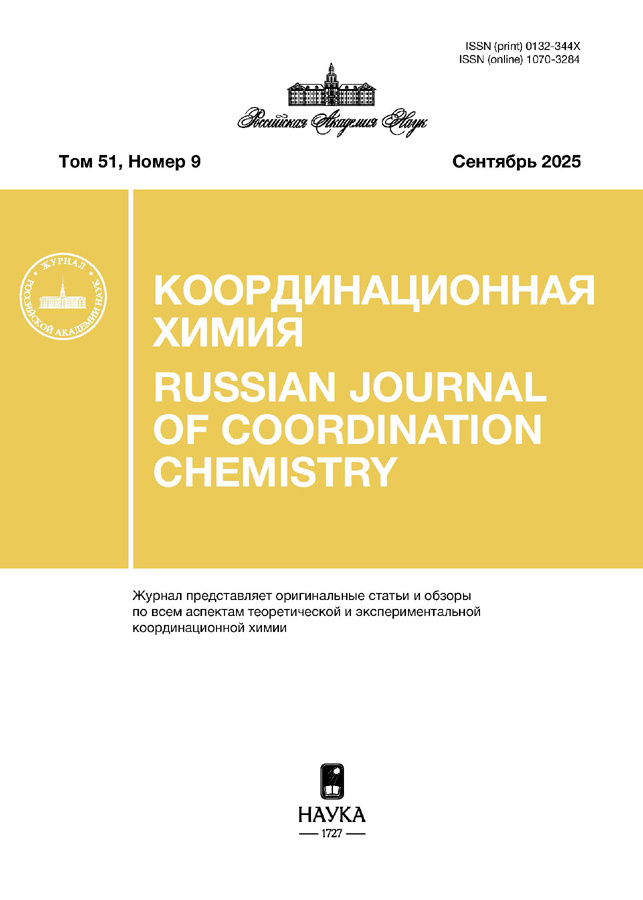Koordinacionnaâ himiâ
ISSN (print): 0132-344X
Media registration certificate: № 0110216 от 08.02.1993
Founders: Kurnakov Institute of General and Inorganic Chemistry of RAS, Russian Academy of Sciences
Editor-in-Chief: Eremenko Igor L., academician RAS, Doctor of Sc., Full Professor
Frequency / Access: 12 issues per year / Subscription
Included in: White list (2nd level), Higher Attestation Commission list, RISC
Ағымдағы шығарылым
Том 51, № 9 (2025)
Articles
Mononuclear diphenyltin (IV) complexes with salicylaldimine Schiff bases. Synthesis, structure, electrochemical properties
Аннотация
New mononuclear tin(IV) complexes were obtained by condensation diphenyltin oxide Ph2SnO with a number of Schiff bases containing hydrazone fragment. The structure of the complexes was confirmed by 1H, 13C and 119Sn NMR spectroscopy, as well as by X-ray diffraction analysis (CCDC 2443096 (IV) и 2443095 (V)). The electronic and redox properties of complexes I–V, including the value of the energy gap, were studied using UV spectroscopy and cyclic voltammetry. Electrochemical oxidation and reduction of complexes I, II, IV and V are irreversible and accompanied by further chemical transformations. Unlike them electroreduction of complex III with a pincer ligand leads to the formation of persistent anion-radical particles.
 541-555
541-555


Terephthalate and N-Oxide Isonicotinate Complexes of the {Mo6I8}4+ Cluster
Аннотация
The reaction of (TBA)2[Mo6I8(OAc)6] with terephthalic acid and isonicotinic acid N-oxide afforded new complexes, (TBA)2[Mo6I8(OOC-C6H4-COOH)6] (I) and (TBA)2[Mo6I8(OOC-C5H4NO)6] (II), respectively. The optimized synthesis of complex II involves microwave activation of the reaction mixture at 130°C in a Teflon reactor of the ETHOS UP Milestone microwave setup. According to X-ray diffraction data, the molybdenum atoms in the cluster cores of I and II are monodentately coordinated by carboxylate ligands. The cluster anions of complex I [Mo6I8(OOC-C6H4-COOH)6]2– are combined into a three-dimensional structure, the crystal structure contains solvate molecules. Samples of complexes I and II were characterized by elemental analysis for C, H, N, IR spectroscopy, electrospray mass spectrometry and proton magnetic resonance. For powder samples of I and II, bright phosphorescence with emission maxima at ~680 nm, φ = 15%, τ = 125 μs (I) and φ = 12%, τ = 137 μs (II) (in air at λExc = 440 nm) was revealed.
 556-565
556-565


SYNTHESIS, STRUCTURE, AND OPTICAL PROPERTIES OF CYCLOMETALATED IRIDIUM(III) COMPLEXES WITH 2-ARYLBENZIMIDAZOLES AND PYRAZINO[2,3-F][1,10]PHENANTHROLINE
Аннотация
Two new iridium(III) complexes with benzimidazole ligands differing in the size of the aromatic system and an auxiliary N-donor ligand with extended conjugated system have been synthesized and studied structurally and spectroscopically. Comparison of the results of crystal packing analysis and data of electronic absorption spectroscopy, diffuse reflectance spectroscopy, and luminescence spectroscopy shows that intermolecular π–π interactions between the benzimidazole ligands have little effect on the optical characteristics of the complexes. Both compounds exhibit light absorption in the range of 250–550 nm (e = 58 000–1 000 M–1cm–1) both in solution and in the solid phase (Eg = 2.14–2.16 eV) and emit in the orange region (λmax = 558–585 nm), with the solid-state emission maxima systematically red-shifted by about 25 nm. The results of the work allow a better understanding of the influence of crystal packing on the optical properties of iridium(III) complexes and will be used for further development of approaches to the crystal chemistry design of luminescent iridium compounds in the long-wavelength range.
 566-575
566-575


Local Atomic Structure of Co(II), Ni(II), and Cu(II) Metallochelates Based on Derivatives of 1-Phenyl-3-Methyl-4-Formyl-5-Pyrazolone and 1-Aminobenzimidazoles
Аннотация
A series of new metallochelates of Co(II), Ni(II) and Cu(II) based on 1-phenyl-3-methyl-4-formyl- 5-pyrazolone and derivatives of 1-aminobenzimidazoles has been obtained. The composition and spectral properties of which were studied using elemental analysis methods, 1H NMR (for HL) and IR spectroscopy. The parameters of the local atomic environment of metal ions in these complex compounds have been determined by X-ray absorption spectroscopy. The experimental structural data are confirmed by the calculation of optimized structures of complexes using the density functional theory method. The important role of additional donor centers (S, Se) and substituents at the imine nitrogen atom in the aminobenzimidazole fragment of ligands on the geometry of the coordination node of complexes is shown.
 576-589
576-589


Spin state behavior of a pH-responsive cobalt(II) complex with a bis(pyrazol-3-yl)pyridine ligand
Аннотация
A new cobalt(II) complex [Co(L)2](ClO4)2 is synthesized by the reaction of 2,6-bis(pyrazol-3-yl)pyridine (L) containing deprotonable hydroxyl groups with cobalt(II) perchlorate hexahydrate in deuterated methanol in an NMR tube. The possibility of its reversible deprotonation under the action of 1,8-diazabicyclo[5.4.0]undec-7-ene in situ is demonstrated. Variable-temperature ¹H NMR studies (200–325 K) reveal that the complex maintains a high-spin state both before and after complete deprotonation. Single-crystal X-ray diffraction data of the fully deprotonated complex [Co(L-2H)2](DBU + H)2 (CCDC № 2448321) indicate that it also retains the high-spin state in the crystalline phase.
 590-600
590-600











